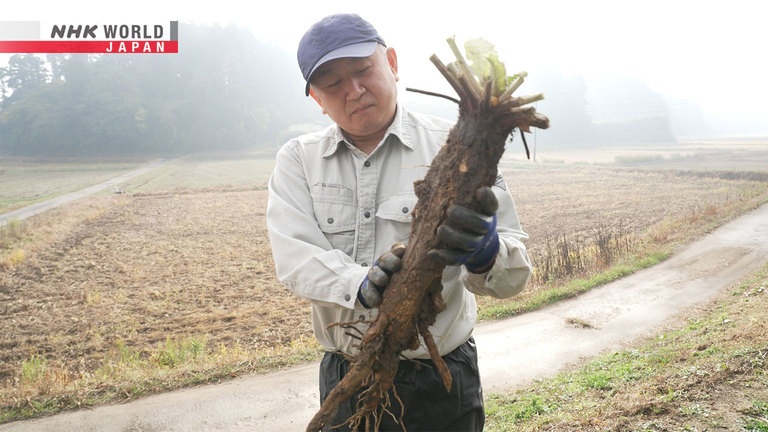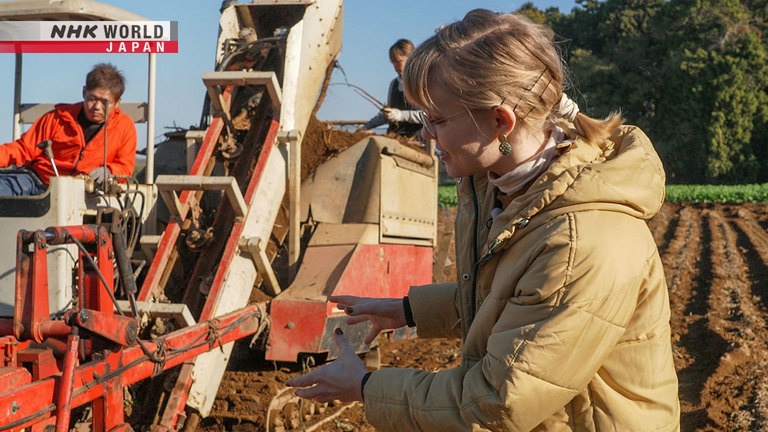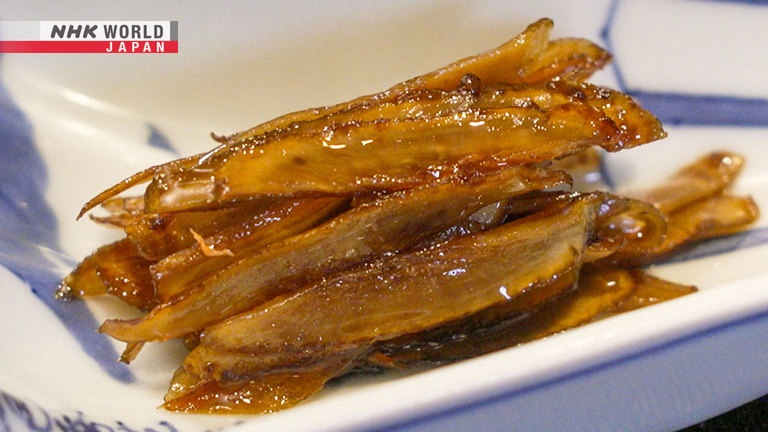GOBO
Japan is likely the only country to have incorporated gobo, a root vegetable, into its diet on such a wide scale. Witness novel and traditional harvesting methods and feast your eyes on unique dishes.




Transcript
Tokyo: this world-class metropolis is a veritable gourmet wonderland.
Discover the stories behind the ingredients that make this city so delicious - so "oishii."
Let's talk about gobo.
It's not a stick; it's a root vegetable packed with historical relevance.
Gobo play a key role in Japanese cuisine, both traditional and modern.
Especially in Japan, all kinds of gobo dishes have become common over the years.
"Oishii!"
Gobo look rather plain, but they offer a rich, earthy aroma and crispy texture that add body to every dish.
Gobo have been consumed in Japan for over 5,000 years.
Dig in to discover more about Japan's beloved root vegetable - packed with nutrients from the earth.
Trails to Oishii Tokyo.
Hi, it's Kailene.
Today's subject is gobo, a root vegetable that I was entirely unfamiliar with when I lived in the US,
but has a long history here in Japan.
In fact, it's said to have been eaten here for more than five thousand years.
I've lived in Japan for around 10 years, so I know a few of the popular preparations of gobo,
yet there's still a lot about the vegetable that I don't know.
Join me today as we learn about gobo.
Kailene begins in Toyosu Market, one of the world's largest wholesale markets.
The produce section offers seasonal fruits and vegetables from across the country.
Daily transactions reach over 2 million dollars.
- Excuse me. I'm Kailene.
- Good morning.
- Do you have any gobo?
- Sure we do.
- They're over here.
- So long!
These are standard ones.
- Standard gobo are this long?
- They are.
We don't have such long root veggies in the US.
Yeah, these aren't readily available overseas.
Kailene speaks with a licensed vegetable specialist named Kajiyama Toshiharu, who will tell her all about gobo.
They grow in the ground, like tree roots.
Like this.
They go deep.
Any thicker and we can't pull them up.
These seem difficult too!
They're in the ground this way.
Any special characteristics?
Mostly aroma.
- I see. Can I try?
- Sure.
- It's a unique aroma.
- Right.
It's earthy.
Actually, the aroma is more
appetizing than I expected.
- Smells good.
- It's tasty.
- But I admire whoever tried gobo first.
- Why's that?
- Who wants to eat a tree root?
- So true.
It took courage to bite into this.
Gobo are native to Asia and Europe.
They came to Japan over 5,000 years ago, where it's said they were initially used for medicinal purposes.
By the 10th century, gobo was being served in meals at the imperial court.
From the 17th century, domestic cultivation had spread, making gobo a more common household ingredient.
Because they grow so deeply into the ground,
they have long been used in celebratory dishes to symbolize longevity.
This is a very rare variety.
- That's gobo?
- Yes.
So big!
Looks like a tree branch.
It's Horikawa Gobo, from Kyoto.
They're pulled from the ground
and put back into the soil sideways.
Interesting.
Then they grow even thicker.
One costs over 20 dollars.
- A luxury veggie!
- A lot of work goes into one gobo.
Sounds like it.
Can it be prepared like other gobo?
The inside is hollow,
so you can stuff it with ingredients.
- It's common in New Year's dishes.
- Wonderful.
Here we have another fun example of something that is 'the same' but very, quite different.
Honestly, if somebody told me that these were both gobo, I wouldn't believe them.
This looks literally like a tree branch.
This is like the gobo that I know.
By being removed from the ground and replanted sideways, the gobo grows thick like a tree root.
This makes for one interesting vegetable!
To try some gobo dishes, Kailene heads to Nihonbashi, an area known for long-established, upscale restaurants.
She finds a restaurant founded in 1935.
Owner Nonaga Kimio has over 30 years of experience.
He's preparing a dish called "kinpira gobo."
Smells great.
My stomach is growling.
Thin gobo slices are stir-fried and seasoned with soy sauce, mirin sweet sake and sesame oil.
It's cooked down until the moisture is gone, and the flavors become dense.
It's classic and mouth-watering - like soul food!
"Oishii."
Nice texture too.
Very crispy.
It has a densely fibrous texture.
I mean, it's very hard to explain.
Gobo has a very particular flavor to it, but it's super delicious.
It has this sort of earthiness to it. A sort of, I don't know...
it feels like you're going back to the roots of cooking.
But combined with the sweetness of the sugar, and the mirin, and the soy sauce and the sake,
you also have this really great complexity happening in your mouth despite the simple number of ingredients you have going on here.
The aroma is similar to beetroot.
Very earthy.
It's too hard to eat whole.
It's thinly sliced to make it easier to eat.
The earthy aroma is evened out with sake,
soy sauce, mirin and sesame oil.
That makes it very tasty.
It's a common household dish in Japan.
This is called "tataki gobo."
Boiled gobo is seasoned with ground sesame, sugar, soy sauce, and vinegar.
It's a common New Year's food in western Japan.
I sliced gobo for the first dish.
How about for this one?
You pounded it.
Doing so loosens up the fibers,
offering a very different texture.
Rich sesame flavor.
Very thick.
I sweeten it with sugar, and add
a savory punch with soy sauce.
The broken-down fibers soak in all that flavor.
I see.
Traditional culinary techniques are used to enhance the gobo's flavor.
For the next dish, he chops gobo into bite-sized pieces.
They're simmered in a soy sauce-based broth with chicken and seasonal veggies.
It's called "chikuzenni" - commonly served at festive events, or right at home.
I'll try the gobo first.
Can you taste the difference?
Yeah, it's less crispy this time.
But it still has a firm texture.
Yes, it maintains its integrity.
It has body and aroma.
Try the broth.
Wow. The gobo adds a lot.
Right? It punches through.
You only get that with gobo.
As a chef, what makes gobo special?
It's a key element of Japanese cuisine.
Whether for home-cooked or festive dishes,
it's the king of root vegetables.
Next, Kailene heads to one of Japan's leading gobo production areas.
Her destination is Hokota in Ibaraki, about a two-and-a-half-hour drive from Tokyo.
Good morning.
Kailene meets with a local farmer named Onose Shogo.
She's just in time for a gobo harvest.
Not what I was expecting.
I only see leaves!
That's right.
Are these gobo?
They are.
Seeds are planted in April, and harvest is from November to March.
Sunlight gives leaves the nutrients needed to grow long, tasty gobo.
Kailene will get a quick lesson about how they grow.
He digs deeply, being careful not to damage any gobo roots.
- Deep!
- It is.
There it is.
I got one.
Interesting.
To take this root he had to dig a hole that was so deep down there. It's a lot of work.
But it smells both like a mix of dirt but also that very distinct gobo smell,
which makes me think it's gonna make a delicious meal.
Onose is very particular about the soil he uses to grow gobo.
- The compost has lactic acid bacteria.
- Really?
Yes.
We feed pigs food containing lactic acid bacteria.
Their waste is used to make compost, and then soft soil.
Humans and vegetables are much the same.
It's thought that giving vegetables what the
human body needs helps them grow better.
Nowadays, gobo harvesting is mainly done by machine.
First, the leaves are mowed away.
Then, they use a large combine designed for gobo harvesting.
Two vibrating blades penetrate and loosen the soil.
In this way, gobo are brought to the surface, and collected by a conveyor belt.
The machine here is amazing. It's simple in how it works,
but you can see that underneath there it's using vibrations to loosen up the earth,
and then just bringing up those gobo to the top.
I mean... I hadn't really seen any sort of farm equipment in person working like this,
but honestly it's a really amazing feat of engineering.
Gobo that the machine missed are harvested by hand.
It's tough.
I see. But since the soil was loosened...
Right, the machine made it easier.
- So you don't have to dig a deep hole.
- Exactly.
Wow! This is so big!
Incredible!
It depends on the field conditions,
but they can get to around this big.
Like a Japanese radish?
Sure. When that thick, it can be
around 1.2 meters long.
We get big ones like that.
They harvest from dawn to dusk.
Four family members and two employees work together.
On a good day, they can collect 9 metric tons of gobo.
After harvest, they're cut to a set length, and sorted by weight.
What's difficult about working with gobo?
Mainly the weather and related conditions.
Some things are beyond our control.
What's fun about it?
A nice harvest brings great happiness.
It means all the hard work paid off.
Shogo's wife, Ayumi, and her mother-in-law, Takae, will use freshly-harvested gobo to make tempura.
Looks great!
May I take a bite?
Go ahead.
"Oishii."
It's freshly made, so it's very aromatic.
Right.
Homemade food is the best.
Next is Ayumi's own creation.
Finely chopped gobo and minced pork are seasoned with soy and oyster sauce,
and wrapped to make dumplings called "gyoza."
Mine don't look good.
Gobo dumplings are a family favorite.
Looks yummy!
"Itadakimasu."
Once again, the gobo adds so much.
Wonderful texture.
It's nice and firm, filling, and people who
don't prefer garlicy dumplings like it a lot.
But gobo are much more than just "oishii."
You probably guessed, but they're also healthy.
Compared to other vegetables, gobo are very high in fiber.
The skin is also rich in polyphenols - a good reason to leave it on when cooking.
At Naritasan Shinshoji Temple in Chiba, east of Tokyo,
a special kind of gobo has been used for offerings for over 1,000 years.
It's called Oura Gobo.
Kailene will speak with farmers who've been growing it for generations.
Good morning.
My name is Kailene.
Thanks for having me today.
Thanks for coming.
Shiina Daisuke leads Kailene to today's harvest field.
Different from what we saw yesterday.
The leaves sit a bit lower.
We space them out so that
the leaves spread out horizontally.
The leaves get in the way of digging,
so we cut them off like this.
Ah, you can cut them easily.
Have a look. We're only part way through,
but this is how it looks.
Different from standard gobo, I think.
It's so big! It's over twice as thick.
Huge!
Oura Gobo are harvested by hand - no machines.
Wow.
Gobo are usually more round.
Ours have a flatter shape.
Also slightly twisted.
Those are the characteristics.
- So big. I'd never guess this is gobo.
- Right.
Interesting.
The goal is to be able to harvest
at least half of what you plant.
It's that difficult to grow?
Yes, because poor weather can cause rot.
- It's a sensitive variety.
- Right.
Currently, only four Oura Gobo farmers have a contract with Naritasan Shinshoji Temple.
The gobo are exclusively grown for the temple.
This spring, Shiina planted seeds for around 600 gobo.
My son is the 5th generation.
He continues our work
protecting the Oura Gobo variety.
Amazing.
Specialized gobo farming handed down over generations.
The protected Oura Gobo are offered each year in early December.
After the gobo are offered at the temple, the lye content is boiled out.
They are then simmered in soy sauce, sake, and sugar for five days,
and served to parishioners during the New Year's holiday.
A few days before Kailene's visit, they dug up some that were too small to offer.
They held on to them to prepare something special for Kailene.
Oh, it's easy to cut.
"Itadakimasu."
A very unique texture,
but a very gobo flavor.
The key trait of Oura Gobo
is that it's softer.
It's quite surprising at first, I think.
It doesn't feel like gobo, but it tastes like it.
Right! It's very interesting.
What makes Oura Gobo special to you?
It's more of an artform than simply growing produce.
Each one turns out differently as well.
I see.
We've been fostering it for generations.
It brings meaning to my life.
Digging them up and seeing the result
is always a moving experience.
For over a thousand years, farmers have proudly kept the Oura Gobo legacy alive.
Back in Tokyo, Kailene visits Roppongi, an area always at the cutting edge of cuisine.
She'll visit a chef known for inventive French recipes using gobo.
Owner chef Takahashi Yujiro trained at a starred restaurant in Paris.
He begins by peeling gobo into long strips.
The strips are dipped in tempura batter and wrapped around Japanese smelt, which are in-season.
And you guessed it - they get deep-fried.
Oh my!
The gobo-wrapped smelt fritter is served on a mountain of fried gobo.
Just one example of his innovative French dishes.
It looks super exciting.
I've never really seen gobo prepared like this before.
The sauce is also made from gobo.
I stir-fried thin slices, and added wine and dashi stock.
A homemade balsamic and fermented mushroom
sauce was mixed in to add richness.
- Grab and dip it with your fingers.
- I see.
- "Oishii."
- Thank you.
The fish and gobo match perfectly.
The gobo flavor is long-lasting.
Gobo skin gets too hard when fried.
I dry it, make it into a powder, and sprinkle it
on top at the end to enhance the gobo aroma.
That's the trick.
Gobo has a distinct flavor.
Is it difficult to use in French cuisine?
In French cooking, ingredients
often get used in various forms.
Gobo can also be pureed, made into a power,
or fried, and it still tastes great.
Gobo is versatile, and it's worth the challenge.
And the next challenge?
Gobo ice cream!
It's topped with truffle, and herbs coated with chocolate and gobo powder.
I'll try ice cream first.
- There's a hint of gobo.
- Right.
It's mild. There's a great balance
between the dairy and earthy aromas.
Thank you.
I mix gobo in a blender to soften its distinct aroma,
leaving just enough behind to go well with the dish.
What makes gobo special?
The main thing is its aroma.
It needs to be utilized well.
Also, gobo offers very different textures
every way you cook it. That makes it fun.
- The sky's the limit?
- Absolutely.
Born of teamwork between nature and humans, gobo is a work of art, offering a true taste of the earth.
With gobo, this classic, heartwarming flavor and aroma offer endless possibilities.
In Tokyo, every ingredient has its own story.